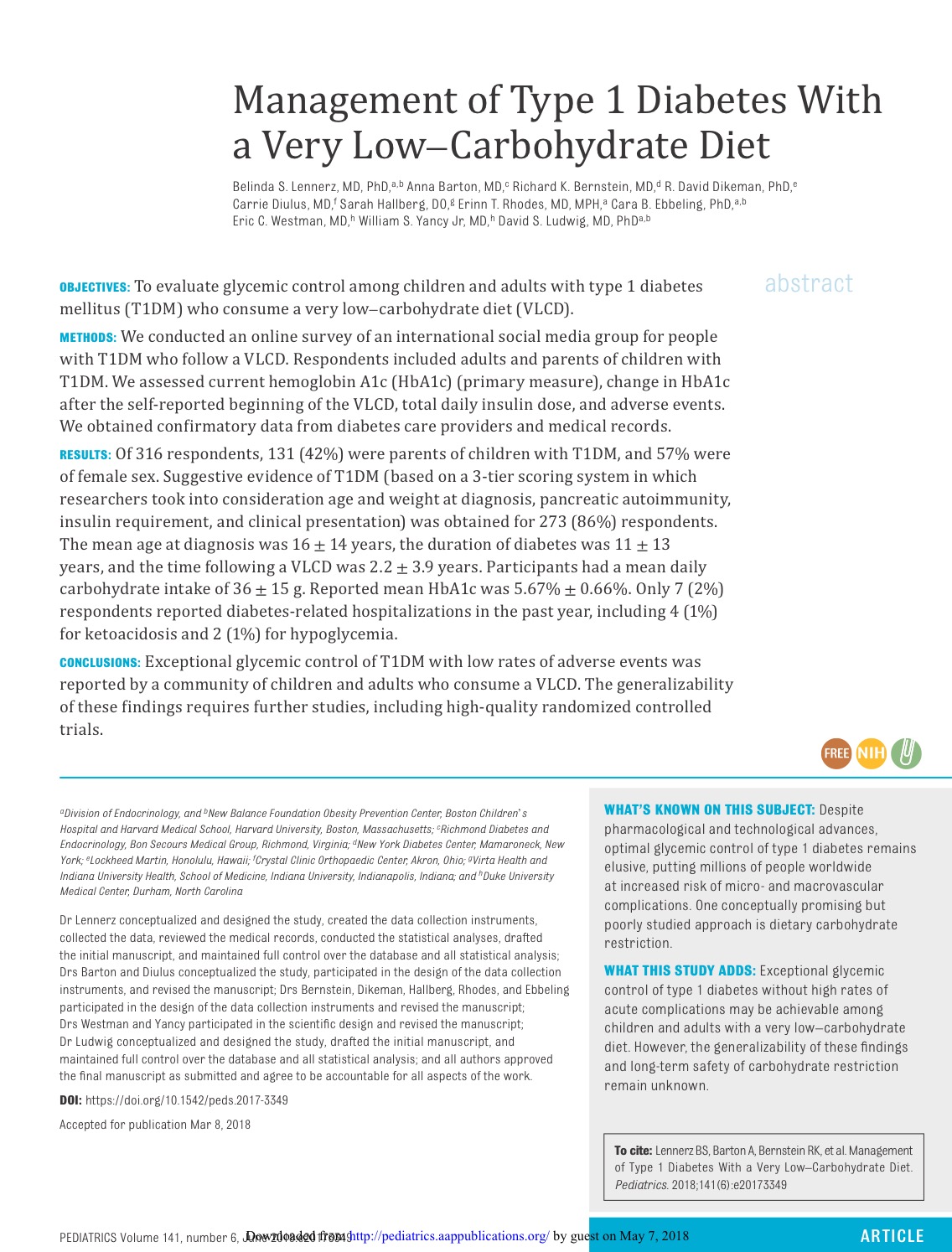Connor (2018) Jak může nízkosacharidová strava pomoci diabetikům 1. typu
![]() eslazeno: New York Times přináší zprávu o nové studii Boston Children’s Hospital/Harvard Medical School, publikovanou v odborném časopise Paediatrics. Studie zjistila, že děti a dospělí na velmi nízkosacharidové stravě s vyšším příjmem bílkovin po dobu asi dvou let, ve spojení s menšími dávkami inzulinu, než jsou obvykle nutné na běžné strave, měli výjimečně dobrou kompenzaci glykémie (hladin krevní glukózy). Měli také nižší výskyt akutních komplikací (hypoglykémií i diabetické ketoacidózy), a děti, které tuto stravu dodržovaly dlouhá léta, nejevily žádné znaky nesprávného vývoje. Průměrná hodnota glykovaného hemoglobinu (HbA1c, také “dlouhý cukr”) činila 5,67 % (38,5 mmol/l), přičemž taková hodnota se považuje za normální a je hluboko pod hranicí pro diagnózu diabetu.
eslazeno: New York Times přináší zprávu o nové studii Boston Children’s Hospital/Harvard Medical School, publikovanou v odborném časopise Paediatrics. Studie zjistila, že děti a dospělí na velmi nízkosacharidové stravě s vyšším příjmem bílkovin po dobu asi dvou let, ve spojení s menšími dávkami inzulinu, než jsou obvykle nutné na běžné strave, měli výjimečně dobrou kompenzaci glykémie (hladin krevní glukózy). Měli také nižší výskyt akutních komplikací (hypoglykémií i diabetické ketoacidózy), a děti, které tuto stravu dodržovaly dlouhá léta, nejevily žádné znaky nesprávného vývoje. Průměrná hodnota glykovaného hemoglobinu (HbA1c, také “dlouhý cukr”) činila 5,67 % (38,5 mmol/l), přičemž taková hodnota se považuje za normální a je hluboko pod hranicí pro diagnózu diabetu.
Abstract
OBJECTIVES: To evaluate glycemic control among children and adults with type 1 diabetes mellitus (T1DM) who consume a very low–carbohydrate diet (VLCD).
METHODS: We conducted an online survey of an international social media group for people with T1DM who follow a VLCD. Respondents included adults and parents of children with T1DM. We assessed current hemoglobin A1c (HbA1c) (primary measure), change in HbA1c after the self-reported beginning of the VLCD, total daily insulin dose, and adverse events. We obtained confirmatory data from diabetes care providers and medical records.
RESULTS: Of 316 respondents, 131 (42%) were parents of children with T1DM, and 57% were of female sex. Suggestive evidence of T1DM (based on a 3-tier scoring system in which researchers took into consideration age and weight at diagnosis, pancreatic autoimmunity, insulin requirement, and clinical presentation) was obtained for 273 (86%) respondents. The mean age at diagnosis was 16 ± 14 years, the duration of diabetes was 11 ± 13 years, and the time following a VLCD was 2.2 ± 3.9 years. Participants had a mean daily carbohydrate intake of 36 ± 15 g. Reported mean HbA1c was 5.67% ± 0.66%. Only 7 (2%) respondents reported diabetes-related hospitalizations in the past year, including 4 (1%) for ketoacidosis and 2 (1%) for hypoglycemia.
CONCLUSIONS: Exceptional glycemic control of T1DM with low rates of adverse events was reported by a community of children and adults who consume a VLCD. The generalizability of these findings requires further studies, including high-quality randomized controlled trials.
Lennerz (2018) Management of Type 1 Diabetes With a Very Low–Carbohydrate Diet
Connor (2018) How a Low-Carb Diet Might Aid People With Type 1 Diabetes


Děkujeme za rychle přeložení z AJ – rychlostí blesku. Díky moc ze do naši malé české země dodávaš tento kvalitní materiál dostupný i ne-anglictinarum. PR
Rado se deje. Brzy jich bude vic. Honza